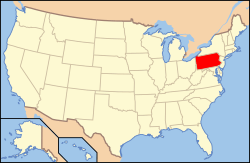Boathouse Row
Boathouse Row is a historic site located in Philadelphia, Pennsylvania, on the east bank of the Schuylkill River, just north of the Fairmount Water Works and the Philadelphia Museum of Art. It consists of a row of 15 boathouses housing social and rowing clubs and their racing shells. Each of the boathouses has its own history, and all have addresses on both Boathouse Row and Kelly Drive (named after famous Philadelphia oarsman John B. Kelly Jr.).
Boathouse Row | |
Boathouse Row | |
   | |
| Location | Philadelphia, Pennsylvania |
|---|---|
| Area | 12 acres (4.9 ha) |
| Built | 1860 |
| Architect | Furness & Evans, et al. |
| Architectural style | Late 19th- and 20th-century Revivals; Late Victorian; Gothic |
| NRHP reference No. | 87000821[1] |
| Significant dates | |
| Added to NRHP | February 27, 1987 |
| Designated NHL | February 27, 1987 |
Boathouses #2 through #14 are part of a group known as the Schuylkill Navy, which encompasses several other boathouses along the river. Boathouse #1 is Lloyd Hall and is the only public boathouse facility on the Row.[2] Boathouse #15 houses the Sedgeley Club, which operates the Turtle Rock Lighthouse. The boathouses are all at least a century old, and some were built over 150 years ago.
History and importance
Boathouse Row hosts several major rowing regattas, including the Aberdeen Dad Vail Regatta, Stotesbury Cup Regatta, the Navy Day Regatta, the Independence Day Regatta, and the Head of the Schuylkill.
The boathouses are seen as centers of the rowing community around the United States. Rowers from the boathouses compete at every level, including local clubs, high schools, colleges, summer racing programs, and international-level athletics.
In 1979, lights designed by architectural lighting designer Ray Grenald were installed to outline each of the boathouses, giving them a nightly Christmas-like gingerbread house appearance and reflecting in the Schuylkill River.[3] He proposed the lights after hearing talk of destroying the decaying Victorian boathouses. Lights on the buildings at night would serve to make them more noticed and appreciated. In 2005, after two refurbishings, the houses were outfitted with computerized LEDs that can light up in various colors, depending on the event or season.
Boathouse Row is a National Historic Landmark and was listed on the National Register of Historic Places in 1987.[4]
Local universities including Drexel, Penn, and La Salle row out of houses on Boathouse Row. Temple and Saint Joseph's row out of other boathouses along the Schuylkill that are not part of the Row.
Early 19th century beginnings
The history of Boathouse Row begins with the construction of the Fairmount Dam and the adjacent water works. The Dam was built in 1821 to keep brackish tidal waters from entering the city's water supply through the Fairmount Water Works, which had been completed in 1815.[5] The Lehigh Coal & Navigation Company would become heavily involved in the improvements.[6] The dam initially submerged the rapids, and later developments transformed the stretch of the Schuylkill between the dam and East Falls from a tidal river into a slack water river resembling a very long freshwater lake.[7] The placid man-made surface was ideal for ice skating in winter and rowing in summer.[5] In 1835, the first regatta took place between the Blue Devils and the Imps Barge clubs.[7] The excitement from the race sparked the formation of several barge clubs, many of them short-lived.[7]
The frame boathouses

A secondary effect of taming the Schuylkill was that the calm water provided a breeding ground for mosquitoes, which drove wealthy residents from their riverside mansions.[5] The abandoned estates were bought by the City of Philadelphia.[7] In 1844, the City purchased the Lemon Hill Estate.[7] The leaseholder of Lemon Hill operated a beer garden and allowed rowing and barge clubs to build frame structure boathouses on the Estate's property along the Schuylkill.[7]
In 1855, the City founded Fairmount Park by converting the Lemon Hill Estate, upon which the frame boathouses were built, into a public park.[7] At the same time, some of the established clubs wanted to regulate the sport of rowing to prevent unscrupulous practices and fixed races.[7] As a result, in 1858, the Schuylkill Navy was founded, which eventually transformed the professional sport of rowing into an amateur sport.[7] In 1859, the City condemned the boathouses along the Schuylkill.[7]
Boathouses of 1860
Although the City condemned the frame boathouses, it passed an ordinance in 1860 to permit construction of three new boathouses for Pacific Barge Club, the clubs of the Schuylkill Navy, and the Philadelphia Skating Club.[7] After 1860, without city approval, several clubs constructed one-story boathouses similar to the frame structures that the City had previously condemned and removed, but these newer boathouses were built with brick and stone.[7] In 1868, following an expansion of Fairmount Park, the City ordered the removal of all of the one-story brick and stone boathouses except for buildings belonging to the Philadelphia Skating Club (#14 Boathouse Row), Pacific Barge Club (#2-3 Boathouse Row), and Bachelors Barge Club (#6).[7]
Post–Civil War boathouses
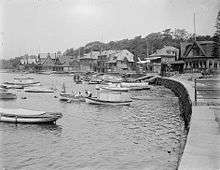
Between 1869 and 1871, Pennsylvania Barge Club and Crescent Boat Club erected a double boathouse at #4 and #5 Boathouse Row.[8] In 1871, the Fairmount Park commission allowed the University Barge Club and the Philadelphia Barge Club to build a double boathouse at #7-8 Boathouse Row.[9] In 1873, Malta Boat Club and Vesper Boat Club built a double boathouse at #9 and #10 Boathouse Row.[10] In 1874, College Boat Club built the boathouse at #11 Boathouse Row.[11] In 1878, West Philadelphia Boat Club built #12 Boathouse Row.[12]
Five years later, in 1883, Undine Barge Club constructed #13 Boathouse Row. In 1892, with Crescent's permission, Pennsylvania Barge Club tore down and replaced their half of the double boathouse at #4 Boathouse Row.[8] In 1894, Bachelors Barge Club replaced its 1860 building at #6 Boathouse Row.[8] In 1902, the Sedgeley Club was allowed to build #15 Boathouse Row.[13] In 1904, Fairmount Rowing Association demolished the stone building built by Pacific Barge Club at #2 Boathouse Row and replaced the 1860 structure with a new brick structure, leaving #3 and #14 Boathouse Row as the only remaining boathouses dating from 1860.[14]
Photo gallery
Historic Landmark Boathouses in 1972
 Sedgeley Club,
Sedgeley Club,
#15 Kelly Drive (1902) Philadelphia Girls' Club,
Philadelphia Girls' Club,
#14 Kelly Drive (1860)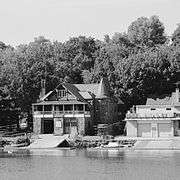 Undine Barge Club,
Undine Barge Club,
#13 Kelly Drive (1883)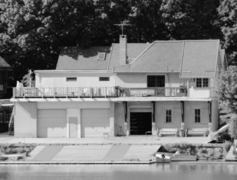 Penn AC Rowing Assoc.,
Penn AC Rowing Assoc.,
#12 Kelly Drive (1878)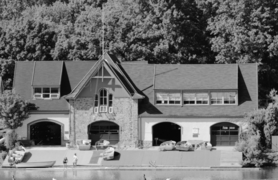 College Boat Club,
College Boat Club,
#11 Kelly Drive (1874) Vesper Boat Club,
Vesper Boat Club,
#10 Kelly Drive (1873)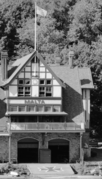 Malta Boat Club,
Malta Boat Club,
#9 Kelly Drive (1873)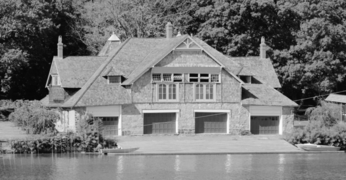 University Barge Club,
University Barge Club,
#7-8 Kelly Drive (1871)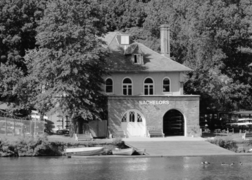 Bachelors Barge Club,
Bachelors Barge Club,
#6 Kelly Drive (1894)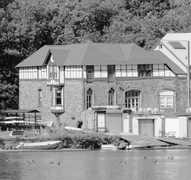 Crescent Boat Club,
Crescent Boat Club,
#5 Kelly Drive (1871)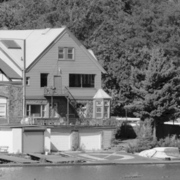 Pennsylvania Barge Club,
Pennsylvania Barge Club,
#4 Kelly Drive (1892)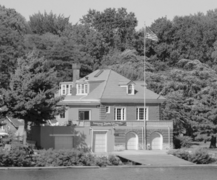 Fairmount Rowing Assoc.,
Fairmount Rowing Assoc.,
#2-3 Kelly Drive (1904)
Miscellaneous images
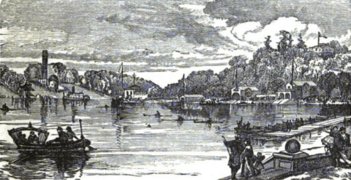 Artist's rendition of the Row (c. 1860-71)
Artist's rendition of the Row (c. 1860-71)%2C_1818_-_9-1905-crop-.png) The Row with Lemon Hill in background (c. 1860-71)
The Row with Lemon Hill in background (c. 1860-71) Boathouse Row (c. 1873-74), from left to right: #14; #9-10; and #7-8 after one-story structures were removed
Boathouse Row (c. 1873-74), from left to right: #14; #9-10; and #7-8 after one-story structures were removed Boathouse Row from the Water Works (c. 1873-74)
Boathouse Row from the Water Works (c. 1873-74) Boathouse Row from Lemon Hill (c. 1873-74)
Boathouse Row from Lemon Hill (c. 1873-74)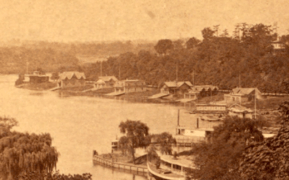 Boathouse Row (c. 1874-77), from left to right: #14; #11; #9-10; #7-8, #6; #4-5; and #2-3 just after #11 was built and before #12
Boathouse Row (c. 1874-77), from left to right: #14; #11; #9-10; #7-8, #6; #4-5; and #2-3 just after #11 was built and before #12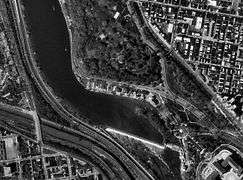 Declassified KH-11 spy satellite image of the Row
Declassified KH-11 spy satellite image of the Row
See also
- List of National Historic Landmarks in Philadelphia
- National Register of Historic Places in North Philadelphia
References
| Wikimedia Commons has media related to Boathouse Row. |
- "National Register Information System". National Register of Historic Places. National Park Service. January 23, 2007.
- "Lloyd Hall". Archived from the original on 2011-07-27. Retrieved 2010-05-11.
- Saffron, Inga (2005-01-07). "Lights Out". The Philadelphia Inquirer. pp. 1, 13.
- National Registry of Historic Places Inventory--Nomination Form Archived 2011-08-18 at the Wayback Machine
- Burt, Nathaniel (1999). "The Schuylkill Navy". The Perennial Philadelphians: the anatomy of an American aristocracy. University of Pennsylvania Press. p. 200. ISBN 978-0-8122-1693-6.
- Archer B. Hulbert, The Paths of Inland Commerce, A Chronicle of Trail, Road, and Waterway, Vol. 21 The Chronicles of America Series. Editor: Allen Johnson (1921)
- Moak, Jefferson (27 November 1983). "National Registry of Historic Places Inventory--Nomination Form". NPS Focus, National Register of Historic Places, National Park Service, US Department of the Interior. p. 669. Retrieved 7 May 2010.
- "National Registry of Historic Places Inventory--Nomination Form". NPS Focus, National Register of Historic Places, National Park Service, US Department of the Interior. 27 November 1983. p. 661. Retrieved 7 May 2010.
- Stillner, Anna (2005). The Philadelphia Girls’ Rowing Club: An Incremental Historic Structure Report (Thesis). p. 28. Retrieved 30 April 2010.
- "National Registry of Historic Places Inventory--Nomination Form". NPS Focus, National Register of Historic Places, National Park Service, US Department of the Interior. 27 November 1983. p. 663. Archived from the original on 27 February 2014. Retrieved 7 May 2010.
- "Seth S. Tannenbaum, Clifton R. Hood, & Mary D. McConaghy, College Boat Club, Penn Crew, archives.upenn.edu (April 2006)". Archived from the original on 2010-06-13. Retrieved 2010-05-26.
- "National Registry of Historic Places Inventory--Nomination Form". NPS Focus, National Register of Historic Places, National Park Service, US Department of the Interior. 27 November 1983. pp. 664–65. Archived from the original on 14 December 2012. Retrieved 7 May 2010.
- Stillner, Anna (2005). The Philadelphia Girls’ Rowing Club: An Incremental Historic Structure Report (Thesis). p. 106. Retrieved 30 April 2010.
- Silverberg, Lee (19 May 2008). "A Very Brief History of the Fairmount Rowing Association". Fairmount Rowing Association. Archived from the original on 4 October 2013. Retrieved 1 May 2010.
External links
- The Schuylkill Navy's website, with links to each of the Boathouse Row websites
- Info on Boathouse Row and Schuylkill Navy
- Boathouse Row, viewed from the air
- Boathouse Row from Historic American Buildings Survey.
- Boathouse Row on wikimapia.org


